

|


THE LENNI LENAPE INDIAN KINGS
Commemorated in a Tavern Name
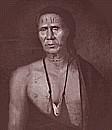
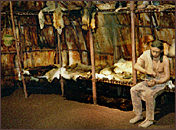
|
|
The Lenape once ruled the area that is now Haddonfield as well as the rest of the Delaware Valley. Left, a Lenape king. Right, recreation of a Lenape hut.
|
|
|
When the first Dutch and Swedish settlers trudged onto the shores of the Delaware River in the opening decades of the 1600s, they encountered native inhabitants who coated their hair with fish oil, pierced their ears with porcupine quills, tattooed their chests with serpent images, and painted their faces with bloodroot sap and yellow ocher.
Living in villages of about 600, these Lenni Lenape people were hunters and trappers -- of deer and elk and beaver -- as well as farmers of maize, beans, pumpkins and tobacco. Also accomplished as fishermen and navigators, they fashioned nets nearly 500 feet long and built gigantic dugout canoes that could hold as many as forty men. They tanned hides, fired pottery and rack-dried vast quantities of fruits, vegetables, meats and fish for storage in underground cellars.
The Benevolent "Indian Kings"
Lenape life was harsh and few individuals lived longer than 40 years; those who did were revered as special beings of unusual wisdom and authority. Each tribe was headed by an older man who was referred to in the aboriginal language as a "Sachem," or chief. Using their own parlance, the newly-landed Europeans called this native leader an "Indian King."
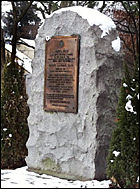 |
|
A memorial at Kings Highway and Chews Landing Road says: "This stone commemorates the spirit of humanity and the kindness existing beween the colonists of New Jersey and the Unalachtigo Lenape Tribe, the original owners of these lands."
|
In the initial phase of contact, the region's Indian Kings viewed the ill-equipped, ill-provisioned Europeans as unfortunate neighbors and were directly responsible for keeping them alive. Tribesmen brought the starving Europeans meat and vegetables through the winter; taught them how to fish the local waters in the summer, preserve what they caught, make maize bread cakes, and successfully treat serious wounds and maladies with medicinal plants.
One of these Indian Kings -- Sachem Ockanickon -- was so responsible for the welfare of European settlers in the area of what is now Burlington and Camden Counties that he became a local legend of mythical proportions. His grave was later topped with a huge stone memorial that marks it yet today. In similar fashion, a stone monument to the Indians was later raised in Haddonfield at the corner of what is now Kings Highway and Chews Landing Road.
Europeans Covet Indian Lands
However, as Europeans continued to flood into the Delaware Valley, their general perceptions and treatment of the Lenape changed. One leading colonist of the era wrote: "I find (the Lenape) entirely savage and wild, strangers to decency and stupid as garden poles, proficient in all wickedness and godlessness; devilish men." Another wrote : "We (must) either convert these tawny serpents or annihilate them."
By 1664, when the English vanquished the Dutch and took over all the area of the Lenape as their own colony, the Indian population had already been decimated by European disease as well as half a century of conflicts with heavily-armed Swedes and Dutchmen. Growing numbers of surviving aboriginal people abandoned the area. When white settlers first landed just after 1600 there had been about 12,000 Lenape living throughout what is now New Jersey. By 1700 there were less than 2,500.
Meanwhile, throughout the east coast colonies, an atmosphere of seige and conflict was the norm for Europeans; virtually all their main towns were walled off with log stockades to protect against attack by Indians whose lands had been seized.
Protests Against Indian Treatment
Back in Europe, one of the few groups that publicly protested the forcible seizure of land and abuse of natives throughout the colonies was the Society of Friends -- the Quakers. A new sect that had evolved in response to England's internal religious wars, the Quakers refused to acknowledge the authority of the Church of England or take part in military activities. They advocated the peaceful settlement of political disputes, tolerance for all religious beliefs and a life lived in service to one's community. Theirs was a faith that sought to make daily acts of kindness the most meaningful form of personal worship.
|
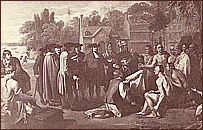
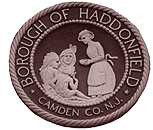
|
|
Left, Penn signs treaty with Indian kings. Right, Haddonfield's official seal depicts its founder, Elizabeth Haddon, with local Indian inhabitants.
|
|
|
One of London's most visible and wealthy Quakers -- William Penn -- stirred a major controversy with his plan for a completely new kind of colonial town that had no stockades or other anti-Indian fortifications. Instead, it would be built as a completely open settlement on land purchased from natives at higher-than-market value, and its European inhabitants would seek to live in harmony with the surrounding aboriginal people. In his famous 1682 meeting (above, left) with the region's Indian Kings on the banks of the Delaware River, Penn signed a treaty of friendship and purchased the ground for his experimental "City of Brotherly Love" -- Philadelphia.
During the next twenty years, Penn traveled back and forth across the Atlantic to recruit new colonial immigrants and investors from among his wealthy circle of Quaker associates in London. One of these, John Haddon, purchased several thousand acres of wilderness along Cooper's Creek in New Jersey, just across the river from Philadelphia.
Elizabeth Haddon and Indians
In 1701, Haddon's 21-year-old daughter set sail from England alone to take possession and oversee the development of her father's land.
She established a primitive Cooper's Creek farm estate called "Haddon Field." Despite the lack of hard historical documentation, the story of her relationship with the local Indians evolved into a much beloved myth now enshrined in Haddonfield's official municipal seal. It depicts Haddon surrounded by local Indians.
One thing that is clear is that the young Quaker woman helped colonize an area of the Delaware Valley where Indians were a significant presence and that she watched the aboriginal culture collapse and virtually disappear by the time she died at age 82
The Disappearing Lenape
In 1750, when Mrs. Haddon-Estaugh was 70 years old and a new tavern building was erected at what is now 233 Kings Highway East, there were fewer than 1,000 Lenape left in all of New Jersey.
This systematic elimination of the local aboriginal people was a topic of much discussion and debate. Many -- perhaps even most -- white colonists hailed it as a triumphant event. Others viewed it as a shameful and completely un-Christian campaign against a worthy and once-proud race of fellow human beings.
In the midst of this emotionally-charged controversy, another local Quaker woman, Sarah Norris, opened a tiny tavern on Kings Highway near what is now Potter Street. It was then customary to mark taverns with bold symbols on large signs. Sometimes the selected symbols had political implications -- such as those of the "Kings Arms," "Royal Oak," or "King George" taverns. More often, tavern owners sought to evoke some local landmark, event or legend that was particularly meaningful -- and hence memorable -- to the area's inhabitants such as "Death of the Fox," "The Roaring Bull," "The Rising Sun" or "The Hounds and Horn" taverns.
Birth of the "Indian King Tavern" Name
Sarah Norris called her establishment "The Indian King" and made the profile of a Lenape chief one of the most visible public symbols in the village. Among other things, her tavern's name harkened back to those brief but transcendent periods when European and aboriginal cultures had interacted with dignity and mutual respect; when powerful Lenape chieftains had ensured the very survival of white colonists with acts of kindness as noble and selfless as those later extended back to them by colonists such as Elizabeth Haddon.
Sarah Norris' landmark Indian King tavern was later taken over by widow Mary French, who went on to marry Hugh Creighton. In 1777, as the Creightons expanded their business in the midst of a Revolutionary War, they purchased the larger 27-year-old tavern across Kings Highway. Then they transferred the well-known "Indian King" name to this larger establishment -- where it remains today.
A POSTSCRIPT: Last of the Lenape
Three years before Elizabeth Haddon-Estaugh died at age 82, the region's last Indians Kings signed a treaty relinquishing all remaining rights and claims in New Jersey and led most of their people west in search of new land beyond European control. The 100 or so Lenapes who elected to stay in the New Jersey area were sent to live at Brotherton, one of America's first reservations at Indian Mills in Burlington County.
The Lenape who migrated inland became part of a vast population of similarly uprooted native peoples who continued to be pushed further west by the unstoppable expansion of the European-based civilization that became the United States. In 1802 the government of New Jersey quietly sold off the Brotherton Reservation at Indian Mills and used the proceeds to remove a tiny group of impoverished inhabitants to upstate New York. In 1890 the Federal Census was able to identify only 84 Indians in all of New Jersey. Today the descendants of the Delaware Valley's Lenape tribes can be found scattered across reservations in Texas, Oklahoma, Wisconsin and Ontario, as well as New Jersey.
In 1997, the state created a Commission on American Indian Affairs and reported that there are about 20,000 native Americans living in New Jersey today, many of whom are members of the state-recognized Ramapough tribe.
|
All Rights Reserved
© 1995 - 2012, Hoag Levins
HoagL@earthlink.net
.
| |
|

|



